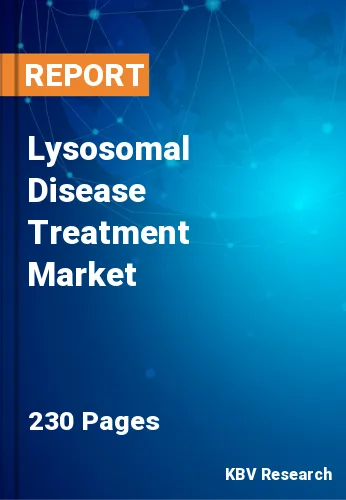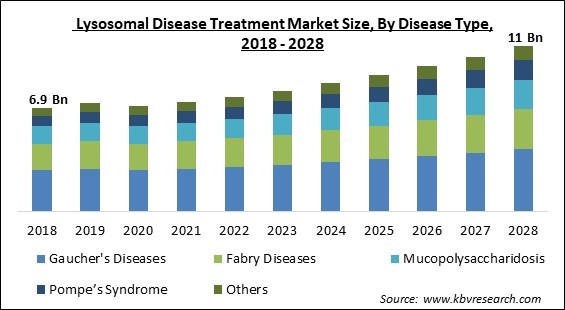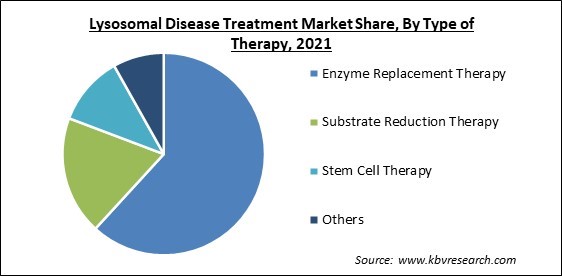
The Global Lysosomal Disease Treatment Market size is expected to reach $11 billion by 2028, rising at a market growth of 6.3% CAGR during the forecast period.
Lysosomal diseases (LSDs) are a complex group of metabolic disorders that are often inherited in an autosomal recessive manner. There are currently 45 known diseases. They are caused by malfunctions in various lysosomal processes, most often by abnormalities in genes that produce catabolic enzymes responsible for the breakdown of macromolecules. As the faulty enzyme accumulates substrate, cell malfunction and clinical symptoms escalate. Other types of lysosomal dysfunction that can lead to lysosomal storage include defects in post-translational processing of lysosomal enzymes, errors in enzyme trafficking or targeting, and dysfunction of non-enzymatic transmembrane and solubilize.

Lysosomal hydrolase mutations, which are implicated in the breakdown of cellular macromolecules, are the primary cause of LSDs, accounting for more than two-thirds of cases. As a result, there are many different types of lipids, glycogen, mucopolysaccharides, and glycoproteins among the storage products in LSDs that are biochemical in origin. The LSDs are all inherited as autosomal recessive characteristics, except the X-linked Fabry, Danon, and Hunter diseases.
The LSDs can affect the majority of organs, either alone or as part of a multisystem illness, and are clinically very heterogeneous. Even though lysosomal enzymes are housekeeping genes and expressed in the majority of cells, the tissues on which they act are distributed much less uniformly, and this determines which tissues in any individual are affected.
The COVID-19 public health crisis has affected almost every industry. The COVID-19 outbreak has caused a significant decrease in demand for the lysosomal disease treatment size of the market across several sectors, especially the health and pharmaceutical sector, as coronavirus crises sweep the globe and force healthcare providers to devote a large percentage of their funds to fighting COVID-19. The risk of infection was the primary factor contributing to the delays in treatment that patients with lysosomal storage disorder encountered in hospitals. The COVID-19 outbreak harms the market's value in 2022 and beyond because it will delay the development of the worldwide market for lysosomal disease treatments.
The primary driving forces in the enzyme replacement therapy market are the expanding research and development for lysosomal disease diagnosis and drug development for treatment. The increasing incidence of lysosomal disease will be a key factor contributing to the acceleration of the market's growth rate. According to a report published by the National Center for Biotechnology Information, the prevalence of Fabry disease in communities of white, male individuals ranged from 1:17,000 to 1:117,000 in January 2020. Atypical presentations were associated with around 1:6000-1:40,000 females and 1:1000-1:3000 males, whereas 1:22,000-1:40,000 males had the classic Fabry disease mutations.
The increases in healthcare spending, which helps to improve its infrastructure, is a crucial element affecting the market's growth rate for therapies for lysosomal diseases. The market dynamics will be further impacted by various government organizations' efforts to strengthen the healthcare infrastructure by boosting funding. Additionally, the market for lysosomal disease therapies will grow as a result of the rising acceptance rate of early diagnosis and the increasing number of government programs to raise awareness. Along with this, expanding government benevolent programs and an increase in disposable money would accelerate market expansion.
Many of the issues that can arise soon after the transplant are caused by the bone marrow being destroyed just before it by drugs or radiation. Some may be unintended consequences of the conditioning procedures themselves. The patient can get support from the transplant team to manage side effects. Most can be addressed to make the patient feel better, and some can be prevented. This is not a comprehensive list, so please inform the physician or the transplant team of any issues or adjustments that experience.

Based on the Disease Type, the Lysosomal Disease Treatment Market is segmented into Gaucher's Diseases, Fabry Diseases, Pompe’s Syndrome, Mucopolysaccharidosis, and Others. The Gaucher’s disease segment acquired the highest revenue share in the lysosomal disease treatment market in 2021. It is due to the rising prevalence of Gaucher's disease is the main market growth driver. Additionally, this segment's growth is fueled by potent approved medications and new treatments that are under development.
On the basis of Type of Therapy, the Lysosomal Disease Treatment Market is divided into Enzyme Replacement Therapy, Stem Cell Therapy, Substrate Reduction Therapy, and Others. The stem cell therapy segment registered a substantial revenue share in the lysosomal disease treatment market in 2021. LSDs are a very appealing target for stem cell therapy due to the capacity to perform cross-correction through secretion-reuptake of lysosomal hydrolases, and allogeneic transplantation of bone marrow was the first specific therapeutic method to be applied to LSDs.
By End-user, the Lysosomal Disease Treatment Market is bifurcated into Hospitals, Clinics, and Others. The hospital segment garnered the highest revenue share in the lysosomal disease treatment market in 2021. due to an increase in people seeking hospital care for lysosomal illnesses. In response to the rising demand for clinical practices to be streamlined cost-effectively, hospitals are using these technologies. A hospital is a facility with skilled medical staff, administrative staff, and medical equipment where people can receive medical care.
| Report Attribute | Details |
|---|---|
| Market size value in 2021 | USD 7.3 Billion |
| Market size forecast in 2028 | USD 11 Billion |
| Base Year | 2021 |
| Historical Period | 2018 to 2020 |
| Forecast Period | 2022 to 2028 |
| Revenue Growth Rate | CAGR of 6.3% from 2022 to 2028 |
| Number of Pages | 230 |
| Number of Tables | 380 |
| Report coverage | Market Trends, Revenue Estimation and Forecast, Segmentation Analysis, Regional and Country Breakdown, Companies Strategic Developments, Company Profiling |
| Segments covered | Disease Type, Type of Therapy, End User, Region |
| Country scope | US, Canada, Mexico, Germany, UK, France, Russia, Spain, Italy, China, Japan, India, South Korea, Singapore, Malaysia, Brazil, Argentina, UAE, Saudi Arabia, South Africa, Nigeria |
| Growth Drivers |
|
| Restraints |
|
Region-wise, the Lysosomal Disease Treatment Market is analyzed across North America, Europe, Asia Pacific, and LAMEA. The North America segment acquired the largest revenue share in the lysosomal disease treatment market in 2021. Due to the lysosomal disease's high prevalence in North America. The development of new medical therapies, advancements in diagnostic technology, and growing public awareness of lysosomal disorders is fueling this market's expansion. Countries have used a variety of strategies that matched their particular needs to address this particular issue of high costs.
Free Valuable Insights: Global Lysosomal Disease Treatment Market size to reach USD 11 Billion by 2028
The market research report covers the analysis of key stake holders of the market. Key companies profiled in the report include Merck & Co., Inc., Johnson & Johnson (Janssen Global Services, LLC), Eli Lilly And Company, Pfizer, Inc., Takeda Pharmaceutical Company Limited, Sanofi S.A., Novartis AG, AstraZeneca PLC (Alexion Pharmaceuticals, Inc.), BioMarin Pharmaceutical Inc. and Sigilon Therapeutics, Inc.
By Disease Type
By Type of Therapy
By End User
By Geography
The Lysosomal Disease Market size is projected to reach USD 11 billion by 2028.
Incidence of Lysosomal Disorders Are Rising are driving the market in coming years, however, The Treatment of Stem Cells Is Fraught with Issues restraints the growth of the market.
Merck & Co., Inc., Johnson & Johnson (Janssen Global Services, LLC), Eli Lilly And Company, Pfizer, Inc., Takeda Pharmaceutical Company Limited, Sanofi S.A., Novartis AG, AstraZeneca PLC (Alexion Pharmaceuticals, Inc.), BioMarin Pharmaceutical Inc. and Sigilon Therapeutics, Inc.
The expected CAGR of the Lysosomal Disease Market is 6.3% from 2022 to 2028.
The Enzyme Replacement Therapy market shows high market share in the Global Lysosomal Disease Treatment Market by Type of Therapy in 2021, thereby, achieving a market value of $6.6 Billion.
The North America market dominated the Global Lysosomal Disease Treatment Market by Region in 2021, thereby, achieving a market value of $4.1 Billion by 2028, growing at a CAGR of 5.2% during the forecast period.
Our team of dedicated experts can provide you with attractive expansion opportunities for your business.
